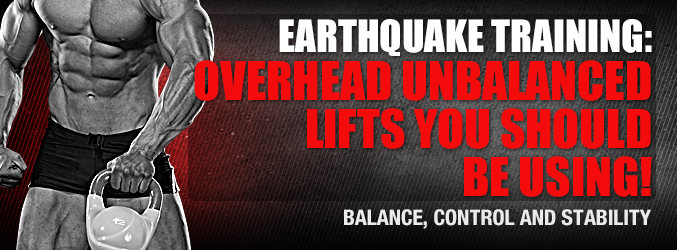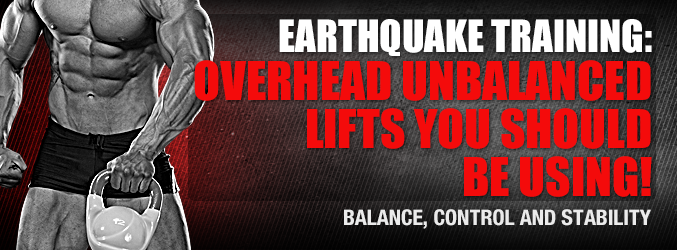
Balance. When you lift any weight during the course of any free weight exercise, you are controlling the movement of the weight against falling, swaying, or dropping. You are solely responsible for ensuring that weight does not come crashing down to the gym floor, or onto you personally. We start as teenagers with very light weights, and move to very heavy weights by our 20s and 30s, often never really giving thought to the fact we are balancing the weight along the way. Balance is very important… but why?
Your body contains some very large muscle groups. You know what they’re called already. Pectorals are the muscles which make up chest. Deltoids are your shoulder muscles. These muscle groups move a weight in one direction or another, always pushing or pulling. But you may be overlooking thousands upon thousands of muscle fibers known as stabilizer muscles. These small rivets of muscle work within muscle groups, as well as between muscle groups, pulling and pushing your muscle groups on all of these lifts that aren’t quite straight push and pull. They offer control, giving you the ability to balance a weight.
Machine-only trainers often neglect these muscle groups. This can go a long way to limiting how much muscle and strength one can develop. A large number of muscle fibers being unutilized or understimulated leaves a lot of wasted muscle on the table. A lack of motor control & stability can also lead to injuries both inside and outside of the gym. Improving your levels of balance and control by targeting these stabilizer muscles should be of utmost importance to lifters. Let’s look at some exercises you can use to target stabilizer muscles.
You will using “oscillating” objects, those unstable movements and awkward lifts which will require you to use very little weight in a very uncomfortable manner. However, the results will be well worth it! The benefits will be better balance, control, and stability both inside and outside of the gym.
Bottoms-Up Kettlebell Press
Start with a kettlebell of moderate weight (15 to 25 pounds) hanging by your side. Lift it over your head, then, keeping it UPSIDE DOWN, proceed to complete overhead presses. You will be forced to grip the kettlebell tightly and show great control as you keep the round ball heavy end of the kettlebell over your head. This movement creates stimulation for the stabilizer muscles from your hip to shoulder to arms to wrist.
Double Offset Overhead Press
This movement may be one that you have never seen, in all your years of training. Grab a 30 pound dumbbell and a 20 pound kettlebell. You can vary your weights once you get the hang of it. Hold one weight in each hand, and press them both over your head simultaneously. You’ll immediately notice you are requiring the exertion of different muscle groups on different sides of your body. Your balance, control and uneven strength will skyrocket as a result of result use of this lift. Don’t worry about creating a muscle balance, however. The next set, you will be switching hands to ensure the sides of the body enjoy equal training and stimulation. Real-lift weights are not always balanced, and this lift will help you prepare for any unbalanced overhead lifting you’ll face!
Double Javelin Press
This may be one of the most awkward and frankly, funny looking, movements you have ever seen completed in the gym before. Pretend you’re completing standing overhead dumbbell presses with your palms facing your head. Now replace the dumbbells… with Olympic bars! Using no weight on the bars, you will be pressing two barbells over you head. Slow & methodical repetitions ensure you target your shoulders as well as your stabilizer muscles without facing injury. Be aware of your surroundings when using this movement!
Draping Chain Overhead Press
This exercise is just how it sounds. You’ll be hanging about 20 pound of chains off of each side of the barbell, then standing and pressing it over your head. The barbell will want to tint and sway. Your job as the lifter is to maintain perfect symmetry when lifting, preventing the quick oscillations. Momentum is NOT your friend on this lift, as you’ll quickly learn. Keep the lift slow and controlled, and try to feel your shoulder muscles doing the lifting work while your stabilizer muscles keep the weight in check.
Hanging Band Overhead Press
This may be the weirdest lift you’ve never seen before – but one that will help boost your proprioceptive mechanisms. Your sensory receptors will be working very hard, continually adjusting the bar in order to compensate for the erratic movement as you lift. Hang a single 10 or 25 pound plate from each side of a standard Olympic bar using hanging bands. Slowly press the weight overhead, forcing nearly every muscle in your body to participate in the difficult task of controlling and very shake, very heavy weight. You’ll boost your motor control, stability and coordination while reinforcing some proper lifting technique as well as symmetrical loading.
Stick with free weight machines, and you will never have to worry about balancing a weight. However, you will also never make the kinds of gains in terms of muscle mass and size, that you need to make if you want to optimize your strength and physique potential.


